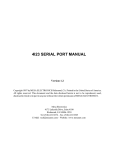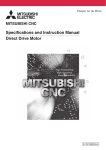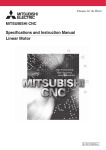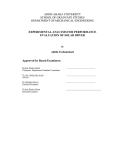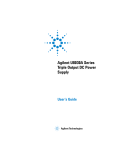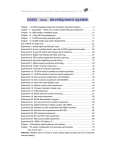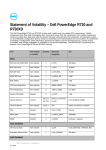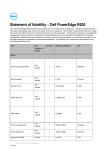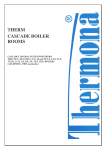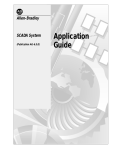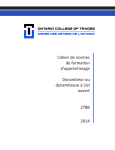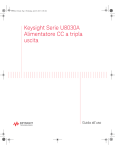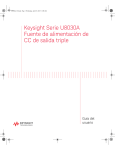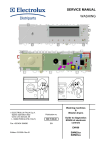Download for more information click here - Electronic & Technical Services Ltd
Transcript
ELECTRONIC & TECHNICAL SERVICES Ltd INSTALLATION AND USER MANUAL E&TS IRRIGATION CONTROLLERS Thank you for purchasing an ETS Irrigation controller If treated in accordance with the following instructions it should give a long and trouble free service. OPERATIONAL FEATURES 1) The digital clock has large bright red digits and is easy to read. 2) 8 programmable starts per day, seven days per week; a total of up to 56 starts per week. 3) Those starts can be set for each day from 1 up to 8 in any sequence, or for a week at a time with “day omission.” 4) It is recommended that no more than 2 valves be connected per station in serial configuration and one valve connected per station in parallel configuration. Each valve is individually time in the parallel configuration. 5) Valve base times from 10s of minutes to 1 second, or to 0.2 seconds for misting. 6) Various types of rainfall sensor can be attached and used to over-ride or integrate external irrigation. 7) Continual cycling is available for misting. No difficult programming is required. Simply connect the Mist controller output into the terminal block labelled “Latched input.” Weaning can be achieved by fitting an ETS Mist Wean controller. 8) An irrigation cycle can be initiated by an external start device which connects the terminal blocks “labelled Mom latch.” 9) Watering by ‘hand’ when a solenoid valve is connected to the ‘Hand watering’ terminal block and to the Common terminal. Pump can be selected from the front panel to run or to be turned off Feed Valve, if available can also be selected. 10) When the panel is running the pump can be turned on or off from the front panel by pushing the tactile switch labelled ‘pump’. The pump ‘state’ will be stored in memory and applied the next time that the panel runs 11) Error checking systems continuously monitor the condition of the rotary switches and look for open or shorted solenoid valve circuits. A built-in sounder, Status LED and station indicator give warning of any error condition, pulsing at a rate specific for the error condition. 12) The duration of all irrigation times can be altered manually by the “Percentage + control” between -90% and +100%. 13) Evaporation or humidity sensors with an output of 0-5Vdc or 0-20mA dc are sampled, integrated and averaged. The algorithm calculates the adjusted irrigation time per station from the output of the sensor. 14)Stations are ‘skipped’ if set above zero with no valve attached. The error checking system will warn of an open circuit valve at the end of the irrigation cycle. 15) The Feed valve can be programmed to any station in serial and to banks of four in parallel. 16) Single station serial operation or single parallel bank operation. MOUNTING AND WIRING UP THE CONTROLLER REFER TO FIG.3 Remove the four screws holding the front panel to the rear enclosure. WITH GREAT CARE remove the three flat ribbon cables from their respective sockets. Please note these are ‘keyed’ and can only be inserted one way. Refit the cables when wiring complete. The controller should be mounted on a flat surface and secured by bolts screwed through the holes provided in each corner of the box. Do not make other holes in the box for this purpose. The ETS controllers should be wired in accordance with FIG.3. IMPORTANT Ensure that the mains supply is disconnected before wiring the controller. Ensure that the mains supply is clean, and that there are no inductive loads such as large pumps or motors on the same supply. It is recommended that the controller be wired directly to the main distribution board. We recommend that you protect the controller with an RCD rated at 2 Amps. Connect:The 240Vac live (brown) wire to the fused terminal block labelled L, The neutral (blue) to the terminal block labelled N, The earth (green and yellow) to the terminal block labelled E. Ensure that the Earth terminal runs to a bonded metal pipe or to a dedicated earth rod, and that the impedance to earth is <5 Ohms. CONNECTING SOLENOID VALVES Connect the solenoid valve 1 to terminal 1, solenoid valve 2 to terminal 2, and so on for the remaining valves. Connect the other wire from each of the solenoids to a common return. The terminal blocks for this are labelled COMM. In the U K it is a statutory requirement that you keep all the low voltage cables clear of the 240vac high voltage supply, in accordance with the Low Voltage Directive. Please take care to do this! CONNECTING THE PUMP The pump cannot be driven directly from the controller. Use an appropriate relay with a 24Vac coil, and connect the relay coil across terminals PUMP and COMM. MORE EXTERNAL INPUTS AND OUTPUTS CONNECTING THE FEED VALVE Connect the solenoid valve across the terminal block labelled FEED and the return to COMM REMOTE STOP, LOW RESERVOIR CUT OUT A closed contact across the terminals labelled Lo res/0V, Lo res will suspend the program. The alarm led will flash and the sounder will beep on/off until the low reservoir fault condition is removed. The program will continue from point of suspension. If a float switch is fitted in the water reservoir and connected to the Lo res contacts, the program will be suspended when the water level in the reservoir drops below the float switch, causing contact closure. The program will remain suspended until the water level increases above the float switch and opens the contacts. REMOTE STARTS There are two kinds of remote starts: momentary and cycling/latched. 1. A momentary start device, such as a closed contact or the output from an Evaporimeter wired across terminals labelled MOMENTARY and common arrow point will start an irrigation program once. The clock display will thereupon read PS1 for no more than four seconds. PS1 indicates that the start has been form an external source 2. A latched or cycling start can be initiated by a suitable device wired across terminals labelled LATCH and common arrow point. The controller will operate the program for as long as these contacts are closed and can be used for misting, multiple cycling and for pulsed irrigation programs.The display will constantly read PS1. HAND WATERING A permanent 24v AC supply is available across HANDWATER and COMM. When this supply is healthy the LED labelled ValveSupply OK is illuminated. Hand watering can be accomplished in two ways: i) pump, selected by pushing the Pump Control push button. ii) pump and feed (where applicable) by selecting Feed Valve push button. The pump and feed valve can be turned on/off by repeated pushes on their respective buttons. The feed valve will always turn off when the pump is turned off. The manual start from the clock is inhibited when hand watering, the automatic start sequence from the clock is not affected. SETTING THE GRASLIN CLOCK Clock has been pre wired, please refer to the manufacturers instructions for clock setting. NOTE. When the clock slide switch is in the ‘ON’ up position, external starts i.e. momentary starts and latched starts are ignored. When the switch is in the ‘AUTO’, middle, or ‘OFF’, down position, external starts will be accepted. The external latched start initiates a single cycle similar to the momentary start. OPERATIONAL FEATURES IN DETAIL: Initial Automatic audit. When power is applied the controller signs on with a signature tune. This indicates that the program is fully functional. The power/int sample led will be illuminated, indicating a healthy 5Vdc power supply SETTING THE DIGITAL CLOCK (See FIG 1) You can set the 24 hour seven day digital time clock to the local time; days, hours x10, hours, minutes x10, and minutes. The battery-backed time base is crystal-controlled and highly accurate; the local time is updated every minute. If the mains power should fail, the re-chargeable battery back-up will ensure accurate time keeping for a minimum of seven days. There are 8 automatic programmable start times. Start times can be set individually or in blocks. The sequence program can be started automatically or manually from the clock. The clock can be reset manually and a new time and day can be programmed if so desired. The clock program operates a number of safeguards to provide a high degree of fail-safe operation. If the clock software detects a problem, the MINS the MINSx10 and the DAY displays will be visible while the error is being corrected automatically. If in the unlikely event that the clock completely ‘freezes’ and pushing the clock set buttons has no effect, remove the jumper labelled CLOCK SUICIDE RESET located on the rear of the main control board FIG.2. This will remove all power from the clock, wait for 2 seconds and replace jumper. All stored information will have been lost, the clock will have to be re programmed. A reset action after removal and replacement of the clock suicide jumper will prevent a spurious irrigation cycle. Your clock will have been set at the factory, and the local time should not require setting. However should you wish to alter the time, or simply familiarise yourself with the workings, here is a step by step guide: Note: if you reset the clock, or if the clock has never been set, the display will flash. This is perfectly normal. Setting the time is the only complicated procedure on this controller. However, if you can set an alarm clock you will have absolutely no problem in setting this one. The clock displays the time in the 24 hour format. Clock access is inhibited when an irrigation sequence is running. TIME DOES NOT AUTOMATICALLY ADJUST FOR BST AND GMT The days will be displayed as follows: = MONDAY t = TUESDAY F = FRIDAY S = SATURDAY HOURS MINS DAYS = WEDNESDAY t. =THURSDAY S. = SUNDAY STARTS 12:00 H OU R S S TAR T MI N S SET T IM E SET S TA R T S C OM M ON S TA R T S SET DAY D A IL Y S TA R TS RESET By default for a new clock, hours, minutes and days will flash As an example it is Tuesday and the time is to be set to 15:30 hours. Setting the Local Time. SET TIME 1. Push and hold the button labelled Then push the button labelled HOURS The hours display will increment (count upwards). When the clock shows 15:00 release the HOURS push button. If you release the SET TIME push button before the HOURS push button a manual start sequence will be initiated. If this is a problem push the reset button to terminate the Sequence 2. Now push the button labelled When 30 is displayed, release the now set. MINS The minutes display will increment. and the SET TIME push buttons. The local time is Next, program the action window which displays the Day, stored starts and the start information. 1. To set the day, which by default is set to Monday (always displayed as Π in the DAYS window) push and hold the button labelled followed by SET SET STARTS TIME When both buttons are held down, the days display will increment from Monday through to Sunday. When the correct day is displayed, release followed by. SET SET Local time and date are now set. START TIME HOURS MINS DAYS 15:30 t H OU R S M IN S S TAR T SET T IM E STARTS SET S TA R T S C OM M ON S TA R T S SET DAY D A IL Y S TA R TS RESET If you make a mistake at any time, simply repeat the above setting procedure. If you want to clear everything back to the default level push the button labelled DAILY STARTS and the push button labelled SET STARTS together. Setting Start Times. When the correct time and day of the week are displayed, the start times can be programmed. The COMMON STARTS button saves you a lot of time because it allows you to apply a common start time to a particular program for up to seven days. Thus, if you programmed a start for 06:30 on Monday, the same start time can be programmed for Tuesday, Wednesday, Thursday, etc through to Sunday, by one touch of the button. The DAILY STARTS button allocates an individual start time to be programmed for a particular day of the week. As an example set the first start time to 06:30 hours 1. Push and hold the button labelled the real time display will show 00:00. tS1. SET STARTS To set the hours push and hold down SET STARTS and Release the HOURS push button. 2. Next, push and hold down SET STARTS and Release the MINS pushbutton HOURS MINS until 06 is displayed. until 30 is displayed. When you are satisfied that the first start time is correct, release the SET STARTS push button. Now allocate that start time to just one day by pushing the or to all 7 days by pushing the button and press the COMMON STARTS DAILY STARTS DAILY START button, button. To check, release SET STARTS push again to scroll through stored start times HOURS MINS DAYS STARTS 06:30 t S 1 H OU R S MI N S S TAR T SET T IM E SET S TA R T S SET DAY C OM M ON S TA R T S D A IL Y S TA R TS RESET The action window should now show the following information: 06:30 tS1 This shows the first start time has been programmed for 06:30 on Tuesday. You can either program the remaining seven starts in the manner described or leave them unused. Keeping the DAILY STARTS pushbutton pressed will scroll through the remaining seven starts all should display 00:00, through to Wednesday which should show the first start time as 06:30 S1, scroll through to Thursday, 06:30 t.S1 etc for the rest of the week. The second start time will now be displayed as 06:30 t S2. this shows that the previous start time has been set has been set at 06:30 and the clock is now waiting for the 2nd start time, pushing either common starts or the daily start will be ignored until a new start time is entered that is different to the first start time, e.g. a new start time of 06:31 will be accepted Note that only one start time will be selected by pushing either COMMON STARTS or DAILY START, Otherwise the same start would be allocated to all start times. All unused starts should be set at 00:00, which is ignored as a start time. If you want to start an irrigation sequence at midnight, set the nearest start time to either 23:59 or 00:01. All other times are permitted. You can program as many starts as you like up to the maximum permitted of eight starts. It is not the sequence of starts that determine the irrigation cycles but the times programmed. For instance if you program start eight with a time of 06:00 hours and start one with 07:00 hours, start eight will run the first irrigation cycle followed by start one. Once all starts have been programmed, to see and confirm your start times push the button labelled DAILY STARTS this will sequence through days and related start times. A mixture of COMMON STARTS and DAILY STARTS is allowed. For instance you may wish to have common starts for Monday, Tuesday and Wednesday but different starts for the remaining 4 days. 1. Sequence through to the day by pushing the DAILY STARTS button, 2. Push the SET STARTS button, select the start time and accept by pushing the DAILY STARTS push button. SET 3. When you are satisfied with all start times push the button, which will return the TIME display to the local time and day. SETTING THE IRRIGATION CYCLE Setting the irrigation cycle is very simple. 1) Set the time base required by turning the TIME BASE rotary switch to the desired time base:- 0.2SECS, SECS, SECS X 10 , MINS, or MINS X 10. 2) Set the station multiplier to the desired setting from 0 to 9. When a particular knob is set to zero, that valve will not be operated, and the controller moves through to the next set station. For example, if the TIME BASE is set to SECS and STN 1 is set to 3 Valve 1 will be on for 3 seconds. 3) Set all remaining stations in the same manner. SEQUENTIAL OPERATION This mode is normally used on smaller controllers. To run it, remove the jumper from the terminals labelled PARALLEL (located on the lower left centre of the rear board, as shown in fig2). When the program runs, the LED for station 1 will be illuminated and voltage will be supplied to valve 1, which should open! At the end of the time set, LED 1 will extinguish and valve 1 will close. The program will sequence to station 2, the LED for which will be illuminated, and valve 2 should open. This process is repeated for each station in turn. PARALLEL OPERATION This mode is particularly useful for larger controllers. To run it, fit the jumper to the terminals labelled PARALLEL, as above. Four stations will operate at the same time, each for the length of time set when it was programmed. When a program starts, the LED’s for stations 1, 2, 3 and 4 will be illuminated and the respective 4 valves will open. As the stations time out the respective station indicator and valve will close. If all the stations are set to the same time all valves and station indicators will open and close together. With the 16 station controller bank 1 stations 1 to 4 come on first followed by bank 2 stations 5 to 8, bank 3 stations 9 to 12 and finally bank 4 stations 13 to 16. 24 through to 48 stations operate in the same manner PROGRAMMING FOR FEED. The software allows the FEED VALVE to be programmed for every station. The FEED can be programmed on or off. When the panel is in a quiescent state pushing the ADVANCE button will illuminate station one and the FEED VALVE led indicators. If feed is to be applied on station one push the ADVANCE button, FEED VALVE led will flash twice and the sounder will beep twice, station two led indicator is now illuminated. If feed is not required on this station, push the FEED VALVE push button, FEED VALVE led will flash once, then extinguish and the sounder will beep once, push the ADVANCE button, station three indicator will be illuminated. Carry on programming in this manner to the sixteenth station. In parallel the feed valve is common to the bank of four stations. Once programming is complete, push the ADVANCE button to check stored FEED VALVE data. Stored FEED VALVE data is retained indefinitely in the event of a power failure. Note that when the feed valve has been selected in a sequence, the FEED led flashes twice, the sounder beeps twice. If feed has not been selected the FEED led does not flash and the sounder is silent. INITIATION OF AN IRRIGATION CYCLE An irrigation cycle can be initiated in three ways: 1)By a timed automatic start. 2)By a manual start. 3)By a remote start. A timed start from the digital clock has been explained in: SETTING THE DIGITAL CLOCK. When the clock initiates a start, the display will show both the real time and what it is doing, displayed for example as FS1 (Friday start 1.) This will be displayed for up to 4 seconds (the clock interrupt routine). Then the action is cleared from the display, which reverts to local time. The manual start from the clock is inhibited when hand watering, the automatic start sequence from the clock is not affected. EXTERNAL STARTS Any device which makes contact across the terminals labeled MOM LATCH or LATCH can be used to start the irrigation program remotely. MOM is generally used for starting irrigation programs, whilst LTH is generally used to start Misting or cycling programs. PROGRAM ADVANCE When the irrigation program is running, pushing the Program ADVANCE button will advance the program to the next station. In parallel the next bank is selected. ALTERING PROGRAM SETTINGS These can be done whilst the program is running, simply by increasing or decreasing the station time, or by selecting a new time base. If you want one station to stop operating, simply set the knob to 0. PUMP The pump output is selected by pushing the PUMP CONTROL button when the program runs. This state is always remembered even when the panel is turned off. This also applies if the pump has been programmed off. The PUMP led indicator is lit when the pump is running. This output can also be used to operate a master valve, a fertilizer injector or similarly related equipment. STATUS When all is healthy the TIMER/PULSE led will flash at the time base rate, for instance if the time base is set to 1 second the TIMER/PULSE led will flash at 1 second intervals. SINGLE STATION (serial) SINGLE BANK (parallel) Initiate an irrigation cycle. Push the ADVANCE to select the station or bank to be irrigated. Push the FEED VALVE push button once, the sounder and Alarm led will bleep and flash twice. The selected station/bank will irrigate once and when complete the irrigation cycle will reset. This feature has to be selected every time an irrigation cycle is initiated. Note. pushing the FEED VALVE during an irrigation cycle will reset the irrigation cycle after the current station has finished watering. DIAGNOSTICS (prevention of glass house flooding) These are carried out automatically when the program is initiated. The program checks for open circuit switches. At the end of the irrigation cycle the faulty switch is identified by the station indicator. If station 3 switch is faulty, station 3 led and sounder will beep and flash twice. This applies to all 16 stations. Once the fault condition has been rectified sounder and led will turn off. However even with a faulty switch, irrigation can safely continue. The software will identify the faulty station and will apply a limited amount of irrigation. In serial this is 50% of the time base, i.e. if switch 3 were faulty and the time base set to 10 secs, irrigation would be applied for 5 seconds. In parallel this is 10% or in the example above 1 second. This process ensures that the glass house is not flooded but there is limited irrigation on the faulty station. Once the faulty switch has been identified rotate the switch vigorously to the left and right, this switching action should clean the contacts. An application of WD40 may also help. To do this , pull off cap and ‘squirt’ down the flat of the spindle. Wipe off excess oil. FAULTY VALVE (on 16 stations and above) To select this function, insert the 2 way jumper taped to the Output board (FIG.3) into the header labelled VALVE SCAN and the 2 way jumper taped to the logic board ito the header labelled VALVE TEST. If not required leave VALVE TEST header empty. If not fitted the controller will skip the valve test routine. In SERIAL - If a faulty valve is detected either open circuit or short circuit, the station and valve are skipped and the next station is selected. At the end of the irrigation cycle the faulty valve is identified by the station indicator. If the valve on station 3 is faulty, station 3 led and sounder will beep and flash three times. This applies to all 16/48 stations. Once the fault condition has been rectified sounder and led will turn off. Upon initiation of an irrigation cycle automatic error checking for all outputs occurs. In serial this consists of a 120mSec sequential pulse to all outputs. Outputs whose stations are set to zero are not checked. In parallel, each output is checked as above in serial mode and then all outputs in a bank of four are checked (all four led’s in the bank are on for 120mSec) for over current. In serial mode short circuit or open circuit conditions give an error warning of 3 beeps and 3 alarm led flashes. In PARALLEL where 1 or 3 stations are safely powering 3 valves with the 4th station open circuit (no valve), the 4th station indicator will flash 3X and alarm sounder will beep 3X. If one of the stations (1 to3) is short circuited (faulty valve) error warning will be 3 flashes and 3 beeps (open circuit) followed by 4 flashes and 4 beeps (short circuit). If all or one of the stations are left open circuit all station indicators will flash 3X and 3beeps followed by 4 flashes and 4 beeps. The valve detection circuit will provide a common error for both short and open circuit. PERCENTAGE ADDITION/SUBTRACTION To select % addition/subtraction place jumper into MAN header on FIG.2 The operator can use a potentiometer labelled %, mounted on the front panel, to increase or decrease all valve times between SCALE +100% and SCALE -90%. On hot days you would increase the % control on dull overcast days you would decrease the % control. When the control is set to “CALIBRATED” the irrigation time is the multiplication time shown on the timer scale as described above. Thus 1. if the time on station one was set to 1 and the time base set to 10 SECS, the % control set to CALIBRATED the irrigation time will be 10 secs. 2. If the % control were set to +100% the irrigation time would be 20 secs. 3. If the% control were set to -90% the irrigation time would be 1 second. The % control will work on the 10 SECS, MINS and MINSX10 time bases, but it has no effect on the 0.2 SECS and SECS time base. Because of the integration software, if the percentage is adjusted prior to an irrigation cycle the RESET button must be pushed, otherwise the percentage would be ‘averaged’. This is explained in greater detail in the integration section. INTEGRATION To select integration place jumper into AUTO header on FIG.2 and disconnect the lead from HDR2, if fitted Simply put, this allows appropriate sensors to adjust the percentage addition/subtraction control described above, automatically and in response to actual conditions.. A 0-5V dc signal is sampled every 5 minutes, indicated by a pulse of the POWER/INT SAMPLE led. up to a maximum of 42 hours. The controller monitors a signal from an evaporation device such as a Solarimeter an Evaposensor , Waterbug or a Delta T device over a set period, usually the period between the controller start times. If all parameters have been set up accurately such as the time base and multiplication factor on the station, the algorithm converts the voltage input into an accurate frequency and automatically calculates the exact amount of irrigation time to compensate for the evaporation period. If sampling exceeds 42 hours, which in effect means that no irrigation has been applied for this period, all information is cleared and the process repeats. The signal from the sensor is sampled, digitised and stored every 5 minutes over a maximum period of 42 hours. If during this period an irrigation cycle is initiated the sum of the digitised samples is divided by the number of samples taken and the resulting average is used to adjust the watering times. Connect the output of your device to the terminals labelled INTEGRATOR and LOWRES/0V terminals located on the output board, refer to FIG.3 Quick Start: 1) Connect controller to the valves, pump and mains supply( refer to the relevant sections in the installation manual) 2) Set the time base 3) Set each station switch, remember the 0 – 9 positions on the switch x the time base. If time base set to 10 SECS and the station switch to 3 the irrigation time is 30 Secs 4) Push the reset button 5) Push the start button, refer FIG 1, digital clock will show PS1 for a max of 4 seconds. 6) Controller runs. CONTROLLER CARE Very low maintenance required. At the end of season keep the mains power applied, this will prevent damp entering and corroding metal parts. To keep the rotary switch contacts clean turn fully to both end stops, DO NOT USE FORCE. DON’T use sharp or pointed objects to push the tactile switches, use fingers only Alarm Conditions 1) Low reservoir 1 beep, continuous, Lo Res led lit 2) Faulty switch 2 beeps, alarm led and station indicator flashes twice. 3) Serial, open circuit valve/short circuit valve 3 beeps, alarm led and station indicator flashes 3X 4) Parallel Open or short circuit valve a combination of 3 and 4 beeps, 3 and 4 alarm led flashes. ELECTRICAL SPECIFICATIONS. Operates from a 240V ac mains supply. Integral 600mA mains suppression filter. F2 Mains fused input rated at 500mA slow blow 5 x 20mm 24V ac output for valves and pump relay F4 rated at 1.5A quick blow 5x20mm Low voltage processor supply F3 rated at 1A quick blow 1 amp 5x20mm 30VA, 24v ac secondary toroidal transformer, maximum output 1Amp Valve common is bonded to Earth Rechargeable clock battery Plastic double insulated enclosure, size 240mm x 190mm x 90mm Declaration of Conformity Name of manufacturer Full postal address Country of origin E&TS Ltd 40 Acreville Rd Bebington Wirral Cheshire CH63 2HY UK Description of product Irrigation Controller Conforms to the requirement of the EMC directive 89/336/EEC, of low voltage directive 73/23/EEC and harmonised European and national standards. Applied standards: EN50081-1 EMC generic emission EN50082-2 EMC generic immunity We declare that as the authorised representatives, the above information in relation to the manufacture of this product is in conformity with the stated standards and other related documents following the provision of EEC directives. CLOCK SUICIDE RESET PARALLEL SERIAL VALVE TEST MAN AUTO FIG.2 HDR2 TB15 INTEGRATOR LOW RES/0v LOW RES MOM LATCH LATCH STATIONS STN56 28 TR55 TR27 TR56 TR28 TR26 TR25 TR54 TR53 TB7 TR51 TR23 TR52 TR24 R9 TR50 TR22 R6 TR49 TR21 C13 TR20 R2 TR48 TR47 R22 R7 TR46 HDR5 HDR3 TB10 C14 TR18 TR17 TR45 C12 TB6 TR44 TR43 R1 R19 R21 R20 S1 TB4 R5 TR15 TR14 R39 TR42 TR41 HDR9 TB9 TR12 TR11 TR40 D3 R26 R25 TR39 HDR7 R28 R4 TR10 TR38 TR37 R24 R23 R29 C17 TB5 STN64 TR64 STN63 TR8 TR63 TR35 R30 R36 R34 TR62 R35 T1 TR34 TB11 TR33 R27 R33 R3 TR7 R31 R32 TR36 STN62 TB14 TR4 C19 FIG.3 TR9 HDR4 STN44 STN16 T2 STN52 STN24 STN43 STN15 TR13 D1 STN51 STN23 INTEGRATOR STN42 STN14 REL1 STN50 STN22 TR19 LOW RES/0v STN41 STN13 TR60 R38 TR32 TR59 TB8 TR31 TB3 TR58 HDR10 TR30 TR57 TR29 Tr65 TRF2 TB1 COMM COMM T3 STN49 STN21 TB12 STN55 27 STN48 STN20 LOW RES MOM LATCH LATCH STN40 STN12 STN36 STN8 COMM COMM R8 STN54 26 STN47 STN19 TR16 STN45 STN39 STN11 STN35 STN7 COMM COMM VALVE SCAN HDR2 TR61 TR5 STN59 TR3 TR2 TR1 COMM COMM D7 D10 U1 STN37 STN34 STN6 STN61 TR6 STN60 STN32 STN31 STN3 STN58 STN57 STN29 FEED PUMP COMM COMM COMM HDR6 STN53 25 STN46 STN18 STN17 STN38 STN10 STN9 STN33 STN5 STN4 STN30 STN2 STN1 HAND WATER COMM COMM R18 PUMPTRIAC HDR1 R17 2 Amps F4 1 Amp F3 LED3 D2 Filter1 FILED 02. 03. 2003. JOHN WALKER 02. 03. 2009. 4-64 NON ISOLATED IRRIGATION OUTPUT TB13 C COMM VALVE SUPPLY OK EARTH C5 C4 TRF1 C1 NEUTRAL VReG C2 TB2 LIVE BR2 F2 C3 500mA HOURS HOURS START MINS MINS SET TIME -25 +100 STARTS RESET RESET PUMP CONTROL FEED VALVE ADVANCE +75 +50 +25 COMMON DAILY STARTS STARTS DAYS SET STARTS % ++ CALIBRATED SET DAY -50 -75 -90 E&TS Ltd For all your irrigation needs 3 4 5 5 TIME BASE 4 5 SECS X10 SECS MINS MINS X10 200mS 4 4 5 STN 4 7 6 2 6 STN 3 3 7 8 6 STN 9 7 0 2 5 8 9 4 1 5 8 4 1 0 6 STN 3 2 7 9 2 6 STN 3 1 0 7 5 2 9 4 1 5 8 4 1 0 3 2 6 STN 3 7 7 9 2 6 STN 3 6 0 7 9 2 6 STN 3 5 0 7 9 2 0 8 5 1 4 8 5 1 4 8 5 1 9 4 8 5 STN 12 7 6 2 3 7 6 STN 3 11 2 6 STN 3 10 7 9 2 7 6 7 8 9 1 0 8 6 STN 3 15 0 2 6 STN 3 9 2 9 7 0 2 9 8 0 1 5 8 4 1 5 8 4 1 5 8 9 4 7 9 STN 16 1 5 2 1 0 6 STN 3 14 7 6 STN 3 13 2 8 9 1 0 8 9 1 3 0 4 1 0 4 8 FEED VALVE ALARM LOW RES POWER/ INT SAMPLE TIMER PULSE PUMP 0




















